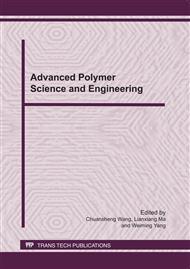p.60
p.66
p.72
p.78
p.85
p.90
p.95
p.99
p.104
Structure and Thermal Properties of Cellulose Diacetate-Graft-Poly(lactic Acid) Copolymer
Abstract:
To improve the thermal behavior of cellulose diacetate, cellulose diacetate-graft-poly(lactic acid) copolymers (CDA-g-PLAs) were synthesized by ring-opening polymerization of L-lactide using stannous octoate (Sn(Oct)2) as catalyst. The molecular structure of the copolymer was characterized by FT-IR and 1H-NMR and the thermal properties were investigated by differential scanning calorimetry (DSC) and thermogravimetric analysis (TG-DTA). The results showed that the product was grafted copolymer of cellulose diacetate-graft-poly(lactic acid) with different side-chain structure. The thermal processing properties of CDA-g-PLAs are remarkably improved with melting temperature(Tm) about 140°C which lower than that of CDA and decomposition temperature (Td) higher than 260°C.
Info:
Periodical:
Pages:
85-89
Citation:
Online since:
March 2011
Authors:
Price:
Сopyright:
© 2011 Trans Tech Publications Ltd. All Rights Reserved
Share:
Citation:


